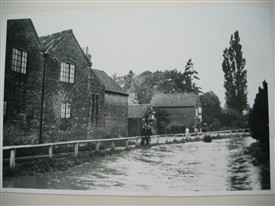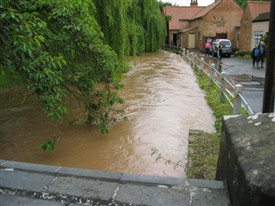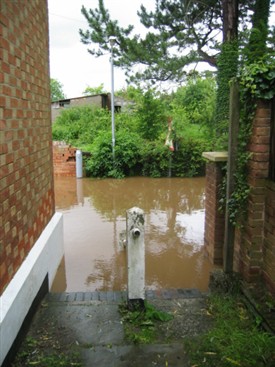CAUNTON

Caunton floods 1922

Caunton floods 2007
P. Reeves

The Steppings 2007
P. Reeves
Location of Caunton floods
A Brief History of Caunton
The first record of Caunton is in the Domesday Book of 1086. It was probably a typical mediaeval village with two or three open fields of strips or ‘furlongs’, traces of which can still be seen today. The village probably changed little until the Enclosure Award of 1795 and the present village layout is remarkably similar to that depicted on the Enclosure Award map.
In the 19th century life in Caunton would have been typical of life in any rural village depending largely on agriculture for its livelihood. The women would work very hard at occupations designed to keep house and make the best use of the small income they would have at their disposal coupled with the use of everything that nature provided in the fields, hedgerows and the cottage garden. The farmhands would wear strong boots made by the village shoe maker, hard wearing corduroy trousers and when needed a hessian sack over their shoulders to try and keep out the rain. Everyone, men, women and children would be expected to attend church or chapel at least once every Sunday.
Caunton being relatively isolated and transport being very limited entertainment had to be home made. Farms brewed their own beer in large quantities especially for times such as harvest festivities. Traditional plays were performed by village folk and local musicians would play for dancing.
Village children had three treats to look forward to, the choir outing, Chapel Sunday School treat and a party to celebrate the end of three weeks peeling willow rods to be used locally for basket making. At the end of harvest there were harvest suppers to be enjoyed at various farms.
Caunton Today
Caunton is a picturesque village located 6 miles N.W. of Newark alongside the A616 road. There are between 400 and 500 inhabitants, a mediaeval church, one public house, a pub/restaurant and a modern infant and junior school. There is no shop nor post-office. A stream called the river Beck runs through the centre of the village and is crossed by a brick and iron bridge on the main street.
A Notable Event
It is said that in the 1450’s, during the reign of Henry VI, one of the first recorded games of football was played in Caunton and that one of the players, William Bartram, was taken to court at Windsor to demonstrate the game and report on his miracle cure. During a game of football William was kicked in his ‘most sensitive parts’. He suffered prolonged agony until in a dream he had a vision of glorious King Henry VI. From that moment he was completely cured.